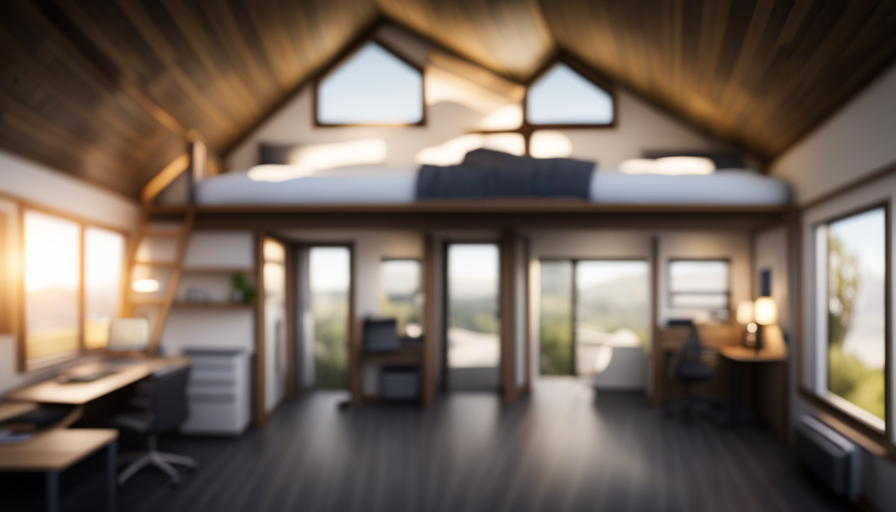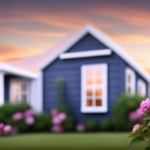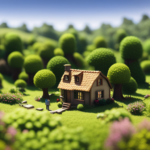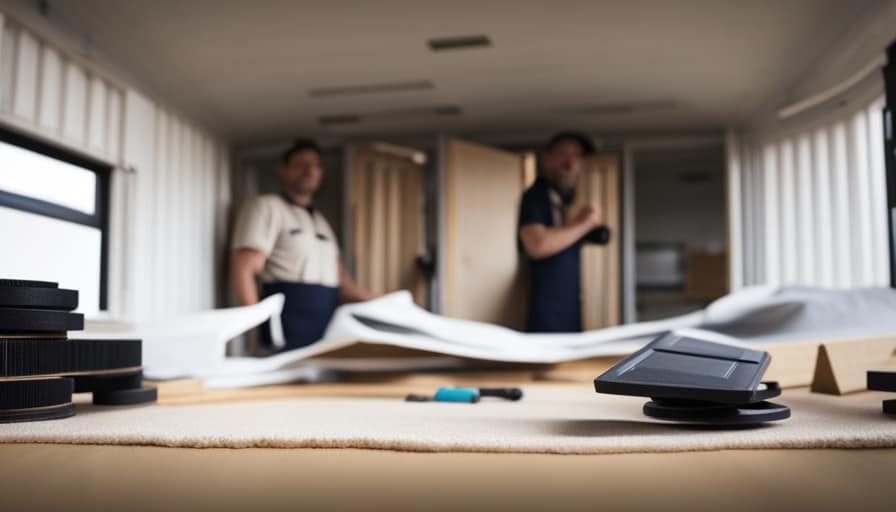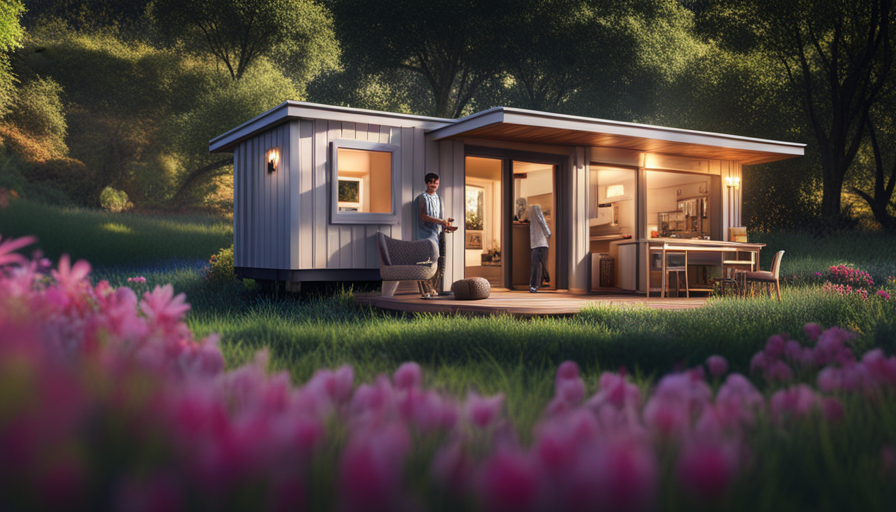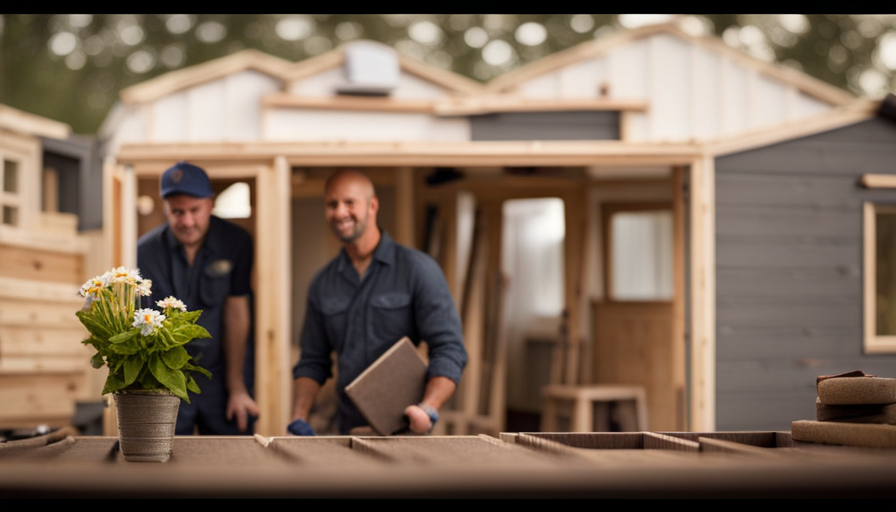Were you aware that the typical size of homes in America has expanded over twofold since the 1950s? Indeed, it has! In an era where larger is frequently perceived as more desirable, there’s an emerging trend towards embracing tiny homes. These diminutive abodes might lack in square footage, but they more than make up for it with their stylish design, practical features, and eco-friendly benefits.
If you’ve ever wondered how many square feet are in a tiny house, you’re not alone. In this article, I will explore the different sizes of tiny houses, the factors that determine their square footage, and the average size you can expect. We’ll also delve into the benefits of living in a tiny house, creative design ideas for maximizing space, and provide real-life examples of these unique homes.
So, whether you’re considering downsizing or simply intrigued by the tiny house movement, keep reading to discover the world of small living.
Key Takeaways
- Average American home size has more than doubled since the 1950s
- Tiny houses are small, compact dwellings ranging from 100 to 400 square feet
- Benefits of downsizing to a tiny house include simpler, more minimalist lifestyle
- Tiny houses have a smaller environmental footprint compared to traditional homes
The Definition of a Tiny House
So, what exactly makes a tiny house, well, tiny? The definition of a tiny house varies, but generally, it is a small, compact dwelling that typically ranges from about 100 to 400 square feet in size.
These homes are designed to maximize space efficiency and minimize unnecessary clutter. The benefits of downsizing to a tiny house are numerous. First and foremost, it allows individuals or families to live a simpler, more minimalist lifestyle. By reducing the amount of possessions and space, people can focus on the things that truly matter to them, such as experiences, relationships, and personal growth.
Additionally, tiny houses are more affordable compared to traditional homes, as they require less materials, energy, and maintenance. They also have a smaller environmental footprint, consuming fewer resources and generating less waste. With these advantages in mind, it’s no wonder that the tiny house movement has gained popularity in recent years.
Now, let’s dive into the different popular tiny house sizes and explore their unique features.
Popular Tiny House Sizes
One of the most sought-after sizes for a popular tiny home is around 200-400 square feet. This size strikes a balance between livability and affordability, providing enough space for essential amenities while still maintaining a compact footprint.
Popular tiny house designs in this range often include clever storage solutions, multipurpose furniture, and efficient use of space to maximize functionality.
The cost of building a tiny house can vary depending on factors such as location, materials used, and level of customization. Generally, smaller tiny houses within the 200-400 square feet range tend to be more cost-effective compared to larger ones. However, it’s important to consider that additional features or high-end finishes can increase the overall cost.
When exploring tiny house options, it’s worth noting that there are many other sizes available. Some individuals prefer even smaller micro-homes, while others opt for slightly larger models. The square footage of a tiny house is often influenced by personal preferences, lifestyle needs, and local regulations.
Moving on to the next section about factors that determine square footage, it’s important to consider various elements that can impact the size of a tiny house.
Factors That Determine Square Footage
The size of a compact dwelling is influenced by various factors, such as personal preferences, lifestyle needs, and local regulations. When it comes to determining the square footage of a tiny house, these factors play a crucial role in defining the space. Let’s take a closer look at some of the key considerations.
First and foremost, personal preferences play a significant role in determining the size of a tiny house. Some individuals may prefer a cozy and compact space, while others may desire a slightly larger area. Lifestyle needs also come into play, as the necessary amenities and functionalities vary from person to person. For example, someone who loves to cook may require a larger kitchen, while someone who works from home may need a dedicated office space.
In addition to personal preferences and lifestyle needs, local regulations also impact the square footage of a tiny house. Different areas have different zoning laws and building codes that dictate the minimum and maximum allowed sizes for dwellings. It’s essential to consider these regulations to ensure compliance and avoid any legal issues.
By considering these factors, individuals can determine the ideal square footage for their tiny house. Now, let’s delve into the average square footage of tiny houses, highlighting the range of sizes commonly found in this popular housing trend.
Average Square Footage of Tiny Houses
When it comes to determining the size of your compact dwelling, you’ll want to know the average square footage of tiny houses in order to get an idea of what to expect.
The average square footage of tiny houses typically ranges between 100 and 400 square feet. However, it’s important to note that there isn’t a set standard for the size of a tiny house, as it can vary depending on individual preferences and needs.
The average cost of a tiny house is another factor to consider. Smaller square footage generally means lower construction and maintenance costs. Tiny houses are known for their affordability, with prices ranging from $20,000 to $100,000, depending on the materials used, location, and amenities included.
In addition to their compact size and lower cost, tiny houses also have a smaller environmental impact compared to traditional homes. They require fewer building materials, consume less energy for heating and cooling, and produce less waste. Living in a tiny house can contribute to a more sustainable lifestyle and reduce your carbon footprint.
Transitioning into the next section, it’s important to consider the numerous benefits of living in a tiny house.
Benefits of Living in a Tiny House
Living in a compact abode offers a multitude of advantages, including lower costs, reduced environmental impact, and the opportunity to embrace a more sustainable lifestyle. When you transition to a tiny house, you not only downsize your living space, but you also downsize your expenses. With fewer square feet to heat, cool, and maintain, your utility bills will significantly decrease. Additionally, the reduced environmental impact of a tiny house cannot be overstated. By living in a smaller space, you consume fewer resources and produce less waste, making a positive impact on the planet.
To illustrate the benefits of living in a tiny house, let’s take a look at a simple table:
| Benefits | Lifestyle Transition |
|---|---|
| Lower Costs | Financial Freedom |
| Reduced Footprint | Eco-conscious Living |
| Minimalism | Decluttered Lifestyle |
As you can see, living in a tiny house not only saves you money but also allows you to transition to a simpler, more intentional way of living. It promotes minimalism and decluttering, allowing you to focus on the things that truly matter.
Transitioning into the subsequent section about the challenges of living in a tiny house, it is important to consider the trade-offs that come with this lifestyle.
Challenges of Living in a Tiny House
Embrace the cozy challenge of living in a small space and experience the saying, ‘good things come in small packages.’
Living in a tiny house definitely has its challenges, but it also has its pros and cons.
One of the biggest challenges is the limited square footage. With such a small space, you have to be strategic about how you use every inch. Storage becomes a major issue, and you have to get creative with finding ways to maximize space.
Another challenge is the lack of privacy. In a tiny house, there is no hiding from each other. You have to learn to live in close quarters and be comfortable with constant togetherness.
On the flip side, one of the pros of living in a tiny house is that it forces you to live a minimalist lifestyle. You have to prioritize what is truly important and let go of unnecessary possessions. It also allows for financial freedom, as the cost of living is significantly lower.
However, it’s important to weigh the pros and cons before diving into tiny house living. Despite the challenges, the rewards can be great.
Transitioning into the subsequent section about creative design ideas for maximizing space, let’s explore some innovative ways to make the most out of your tiny house.
Creative Design Ideas for Maximizing Space
When it comes to maximizing space in a tiny house, there are several creative design ideas worth exploring.
One option is incorporating loft beds, which not only save floor space but also provide a cozy sleeping area.
Another idea is to invest in multi-functional furniture, such as a sofa that can transform into a bed or a coffee table that doubles as a workspace.
Lastly, clever storage solutions, such as built-in cabinets and hidden compartments, can help keep belongings organized and out of sight, making the most of every inch available.
Loft Beds and Storage
With loft beds and clever storage solutions, you can maximize the square footage in your tiny house. By incorporating loft bed designs, you can create an elevated sleeping area that frees up valuable floor space. This not only adds a cozy and unique element to your home, but it also allows you to utilize the area underneath for various purposes.
To further optimize space, consider investing in space-saving storage options. Utilize vertical space by installing floating shelves or wall-mounted cabinets. Utilize hidden storage compartments within your furniture, such as ottomans or coffee tables with built-in storage. Don’t forget about utilizing the space above your kitchen cabinets or under your stairs. These clever storage ideas will help you keep your tiny house organized and clutter-free.
Transitioning into the next section about multi-functional furniture, you can truly make the most out of every square foot in your tiny house.
Multi-functional Furniture
Get ready to transform your limited space into a versatile oasis with furniture that pulls double duty, like a sofa that easily converts into a comfortable bed, providing you with the best of both worlds.
Multi-functional furniture is a game-changer when it comes to maximizing the square footage of a tiny house. These innovative pieces are designed with space-saving in mind, offering practical solutions for your everyday needs.
From coffee tables that can be raised to dining table height, to ottomans with hidden storage compartments, every inch of your tiny house can be utilized efficiently. With their clever designs, multi-functional furniture allows you to have a living room, dining area, and bedroom all in one compact space.
Now let’s explore some clever storage solutions that will further optimize your tiny house living experience.
Clever Storage Solutions
Transform your limited space into a versatile oasis with clever storage solutions that’ll optimize your tiny living experience.
Here are three space-saving techniques that’ll make every square foot count:
-
Wall-mounted shelves: Utilize vertical space by installing shelves on the walls. These shelves can hold books, decorative items, and even kitchen supplies, freeing up valuable floor space.
-
Hidden storage compartments: Invest in furniture pieces with hidden storage compartments, such as ottomans with removable tops or beds with built-in drawers. These clever designs allow you to store your belongings out of sight, while still keeping them easily accessible.
-
Overhead storage: Make use of the often overlooked space above your head. Install overhead storage racks or hanging baskets to store items like seasonal clothing or rarely used kitchen appliances.
By incorporating these clever storage solutions, you can maximize the functionality of your tiny house.
Now, let’s explore some real-life examples of tiny houses, showcasing how homeowners have perfected the art of living in small spaces.
Real-Life Examples of Tiny Houses
When it comes to tiny houses, there are countless unique and innovative designs to explore. From clever storage solutions to multi-functional furniture, these tiny homes are a testament to creativity and ingenuity.
Additionally, touring tiny house communities allows you to see these designs in action and get a sense of the tiny house lifestyle.
Lastly, if you’re feeling inspired, there are plenty of DIY tiny house projects that can help you create your own dream home on a smaller scale.
Unique and Innovative Designs
With its cozy layout and creative use of space, a tiny house becomes a captivating puzzle box that unfolds to reveal hidden treasures. These unique designs and innovative solutions make tiny houses a fascinating option for those seeking a minimalist lifestyle. From multi-functional furniture to clever storage solutions, tiny houses are designed to maximize every square inch. One example is the use of loft beds or storage space beneath the floorboards. Another example is the integration of foldable furniture and retractable walls that allow rooms to transform into different spaces. To further illustrate these designs, take a look at the table below showcasing five innovative tiny house features:
| Feature | Description |
|---|---|
| 1 | Multi-functional furniture |
| 2 | Loft beds and storage space |
| 3 | Foldable furniture |
| 4 | Retractable walls |
| 5 | Integrated storage solutions |
These unique designs and innovative solutions are just a glimpse into the world of tiny houses. Now, let’s transition into the next section and explore the experience of touring tiny house communities.
Touring Tiny House Communities
After exploring all the unique and innovative designs of tiny houses, I couldn’t help but wonder what it would be like to actually live in one. So, I decided to embark on a journey to tour various tiny house communities.
These communities have become popular tourist attractions for those seeking a different way of living. As I traveled from one community to another, I was amazed by the sense of community and creativity that each one possessed. It was fascinating to see how people made the most of limited square footage in their tiny homes, creating functional and stylish living spaces.
Not only did I get a glimpse into the tiny house lifestyle, but I also learned about the cost of living in these communities, which is often much lower than in traditional homes. As I continued my journey, I couldn’t wait to discover more inspiring DIY tiny house projects and learn about the endless possibilities of living in a small space.
Inspiring DIY Tiny House Projects
Imagine the satisfaction you’ll feel when you transform a humble abode into a breathtaking, space-saving masterpiece through these inspiring DIY projects. With a little creativity and some budget-friendly tiny house designs, you can create a personalized oasis that maximizes every square inch.
One inspiring project is building a loft bed with storage underneath, allowing you to utilize vertical space and keep your belongings organized.
Another idea is repurposing old wooden pallets to create unique furniture pieces, like a stylish dining table or a cozy seating area.
Additionally, installing sliding doors can save space and add a touch of elegance to your tiny house.
These inspiring DIY projects will not only help you make the most of your limited square footage, but they will also create a warm and inviting atmosphere.
Now, let’s dive into some tips for transitioning to a tiny house lifestyle.
Tips for Transitioning to a Tiny House Lifestyle
To truly thrive in a tiny house lifestyle, embrace the transition by taking thoughtful steps and tailoring your habits. Transitioning to a tiny house can come with its fair share of challenges, but with some space-saving techniques and a positive mindset, you can create a comfortable and fulfilling living space.
One of the biggest challenges when transitioning to a tiny house is adjusting to the limited space. However, with smart organization and storage solutions, you can make the most of every square inch. Utilizing vertical space with shelves and wall-mounted storage can help free up valuable floor space. Additionally, incorporating multi-functional furniture, such as a sofa that doubles as a bed or a dining table that can be folded away, can maximize the usability of each room.
To help you visualize the possibilities, here is a table showcasing some space-saving techniques:
| Technique | Description | Benefits |
|---|---|---|
| Lofted Sleeping Area | Utilize the vertical space by having a lofted area for sleeping. | Creates more living space below. |
| Hidden Storage | Incorporate hidden storage compartments under furniture or stairs. | Maximizes storage without clutter. |
| Compact Appliances | Opt for smaller appliances that save space without sacrificing | Efficient use of limited square feet. |
By implementing these techniques and embracing the tiny house lifestyle, you can create a cozy and efficient living space. In the next section, we will explore my final thoughts on living in a tiny house and the overall benefits it brings to your life.
Final Thoughts on Living in a Tiny House
Transitioning to a tiny house lifestyle can be a big adjustment, but it’s a change that offers numerous benefits. As I settled into my tiny home, I quickly realized that living minimally wasn’t only freeing, but also allowed me to focus on what truly matters in life.
Now, as I reflect on my experience, I want to share some final thoughts on living in a tiny house.
One of the most significant advantages I’ve found is the financial aspect. By downsizing to a tiny house, I’ve significantly reduced my monthly expenses. With fewer square feet to heat, cool, and maintain, my utility bills have plummeted. Additionally, the lower cost of living has allowed me to save more money and pursue my passions without the burden of a hefty mortgage or rent payment.
Living in a tiny house has also had a profound impact on my mindset. I’ve learned to prioritize experiences and relationships over material possessions. With limited space, I’m forced to be intentional about what I bring into my home, which has led to a more clutter-free and peaceful environment.
Transitioning to a tiny house lifestyle has been a transformative journey. The financial advantages and the ability to live minimally have granted me a newfound sense of freedom and fulfillment.
Frequently Asked Questions
Are there any legal restrictions or regulations regarding the size or square footage of a tiny house?
There are legal restrictions and building codes that govern the size and square footage of a tiny house. These regulations vary depending on the location and may impose minimum requirements or restrictions on the maximum size allowed.
How much does it typically cost to build or buy a tiny house?
It typically costs around $20,000 to $150,000 to build or buy a tiny house. DIY options can be cheaper, but require time and skills. Pre-built options offer convenience, but are generally more expensive.
Can I customize the design and layout of a tiny house to fit my specific needs and preferences?
You can definitely customize the design and layout of a tiny house to fit your specific needs and preferences. There are plenty of customization options available, allowing for space optimization and making the most out of every square foot.
Are there any financing options available for purchasing a tiny house?
Financing options for purchasing a tiny house include loans from banks or credit unions. Pros include low interest rates and longer loan terms, but eligibility requirements may vary. Alternative funding sources like crowdfunding can also be considered.
How do tiny houses compare in terms of energy efficiency and sustainability compared to traditional homes?
Tiny houses offer numerous energy efficiency benefits, such as reduced heating and cooling costs due to their smaller size. Additionally, their smaller carbon footprint and use of sustainable materials make them more environmentally friendly than traditional homes.
Conclusion
In conclusion, living in a tiny house can be a transformative experience. The benefits of minimalism, sustainability, and financial freedom are just a few of the reasons why people choose this unique lifestyle.
By maximizing space and getting creative with design, tiny house dwellers are able to create cozy and functional living spaces. Just like the saying goes, "Good things come in small packages," tiny houses prove that size doesn’t matter when it comes to comfort and happiness.
So, if you’re ready to downsize and simplify your life, a tiny house might just be the perfect fit for you.
Hi, I’m Emma. I’m the Editor in Chief of Tiny House 43, a blog all about tiny houses. While tree houses are often associated with childhood, they can be the perfect adult retreat. They offer a cozy space to relax and unwind, surrounded by nature. And since they’re typically built on stilts or raised platforms, they offer stunning views that traditional homes simply can’t match. If you’re looking for a unique and romantic getaway, a tree house tiny house might just be the perfect option.
